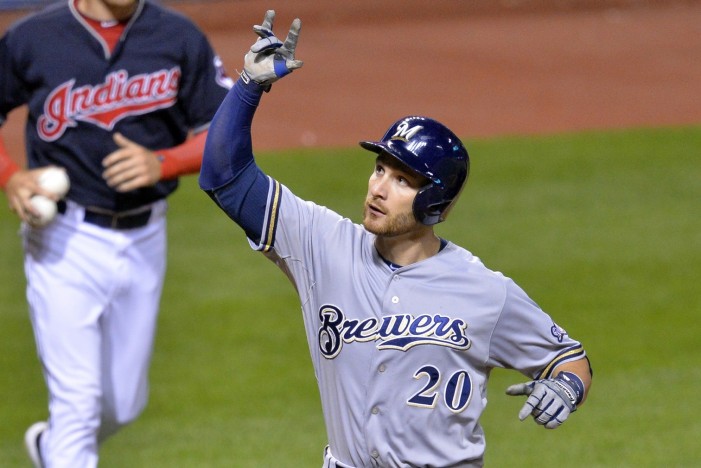If the Brewers are indeed open to trading him, Jonathan Lucroy could be one of the hottest commodities available on the trade market. Given the fact that very few attractive options on the free-agent market at catcher existed at the beginning of the offseason, it has become even more barren with Matt Wieters acceptance of his qualifying offer from the Orioles. In fact, none of the catchers remaining on the market are likely to be given starting jobs. So why hasn’t Lucroy been traded? Or at least involved in more rumors?
By this point last year, the Toronto Blue Jays and Oakland Athletics had completed a deal that included Josh Donaldson. This isn’t used as a reason to trade Lucroy as early as possible, though — just the opposite. Donaldson ended up bringing in a pretty nice return for the Athletics, but one has to admit that it’s nothing that quite compares to acquiring the American League’s Most Valuable Player. The Athletics acquired Brett Lawrie, Kendall Graveman, Franklin Barreto, and Sean Nolin. While that may seem underwhelming to some, Barreto is now the 18th-ranked prospect in all of baseball by MLB.com and the seventh-best shortstop. In short, this trade is a long way from actually being decided.
However, the above anecdote serves a purpose. Billy Beane is a veteran general manager. He knows what it feels like to lose a trade. He knows what it feels like to win a trade. If new Brewers GM David Stearns opts to part ways with Jonathan Lucroy — a major face of the Brewers franchise for the past half-decade — it would have to be for the right package of prospects. One that would be easy to defend to the media.
Furthermore, the free-agent market at the time of the Donaldson trade had just dried up. Having been saturated with both Pablo Sandoval and Hanley Ramirez, the Blue Jays may have felt a knee-jerk reaction to close a deal for a different option. In some ways, a saturated market may actually help a player’s trade value. Well, at least a saturated market that suddenly becomes empty.
I know, that seems counter-intuitive in some ways. How could a player’s value increase when more options exist? Basic economic principles of supply and demand fly in the opposite direction. But trends may actually bend the other way.
For instance, take what is happening in the starting pitching market. The 2015 free agent class is one of the best we’ve seen and will be much, much better than 2016. But did this surplus hurt Jordan Zimmermann’s value? He’s got a freshly-inked deal worth $110 million. Does it seem to have hurt Shelby Miller’s worth? The Atlanta Braves are reportedly asking for an A.J. Pollock or a Matt Duffy. Will it hurt Zack Greinke’s worth? He was so confident in his value that he opted out of a deal that still had $71 million on it. Did this impending market seem to hurt David Price’s worth as a rental halfway through the year? The Detroit Tigers got Daniel Norris, Matt Boyd, and Jairo Labourt. Of course, value becomes different to a team in a playoff hunt, but similar logic can be assigned to Lucroy.
I will now pose to you my theory and it’s yours to accept or deny. Devoid of the fact that Donaldson went on to win the AL MVP, the Athletics got fairly good value for their star third baseman. Furthermore, the Donaldson trade was partially a product of the Sandoval and Ramirez signings. Alex Anthopoulos — the Blue Jays GM at the time — was fully aware of what Sandoval and Ramirez were worth on the open market. So too was Beane. If you are going to make your players available, it then bodes well to have players of the same position become unavailable recently. That is to say, you don’t necessarily want a barren market to drive value, but you want a very recent loss-of-value.
This theory revolves around only observed evidence. Whether it’s believable or not is largely incumbent on if general managers are as fickle as other members of society. Some of us just had the hellish nightmare pleasure of watching full-grown adults take items away from children just so that they could get the best deal on Black Friday. Do adults really want that item that bad? Or is it — at least partially — because that item is just flying off the shelves quickly? If general managers are exploring options at catcher and suddenly see their options disappear in front of them, then the likelihood that someone overpays to acquire Lucroy drastically increases.
So, you have a new GM — but by no means necessarily a tentative one — in Stearns, waiting for the right deal on Lucroy to insure both good value and future prosperity. Despite the fact that the Brewers seem to be in rebuild, Stearns really shouldn’t feel pressured to move Lucroy this offseason. Unfortunately for Stearns, you can’t just create a surplus in the catching market. While this trade may take a while to materialize largely, Stearns’ patience seems to bode well, despite Lucroy’s expiring contract. Keeping the 29-year old Lucroy on a rebuilding team is a good idea not only because of his elite talent, but also because it can’t hurt his value after a slightly-down 2015 season.
